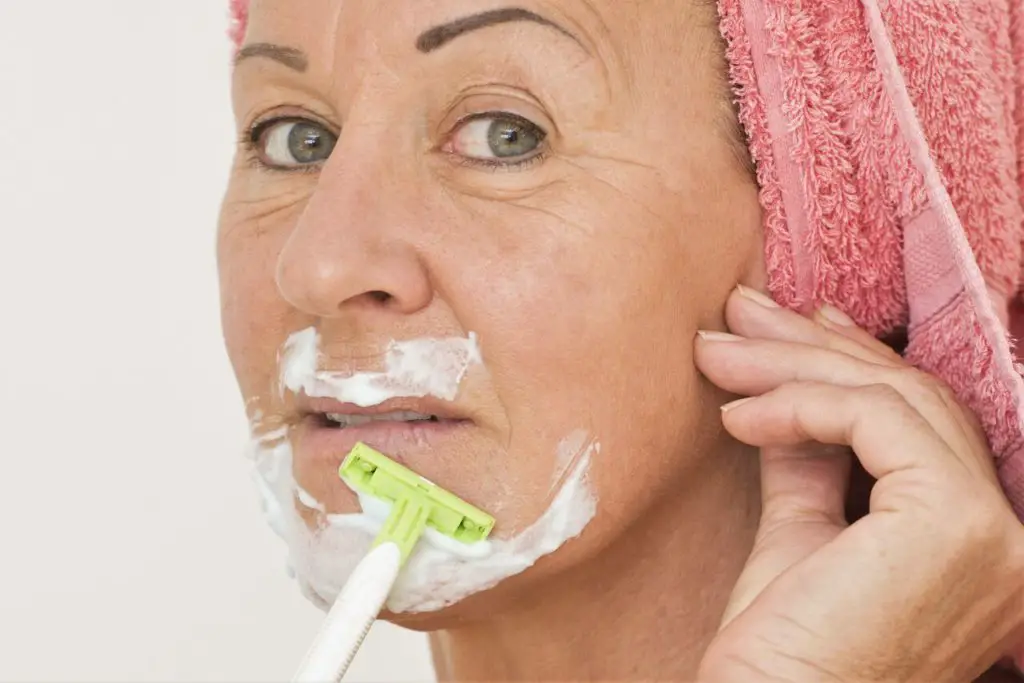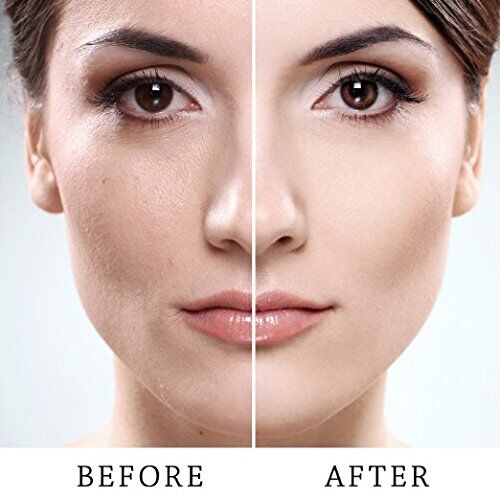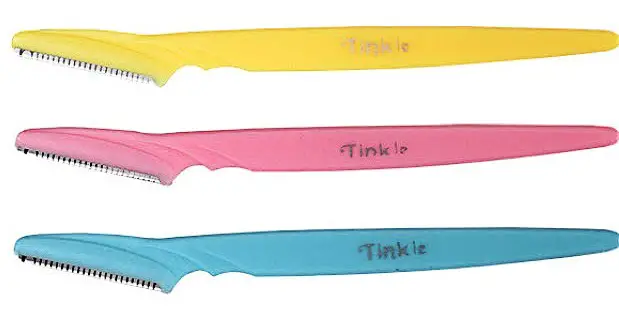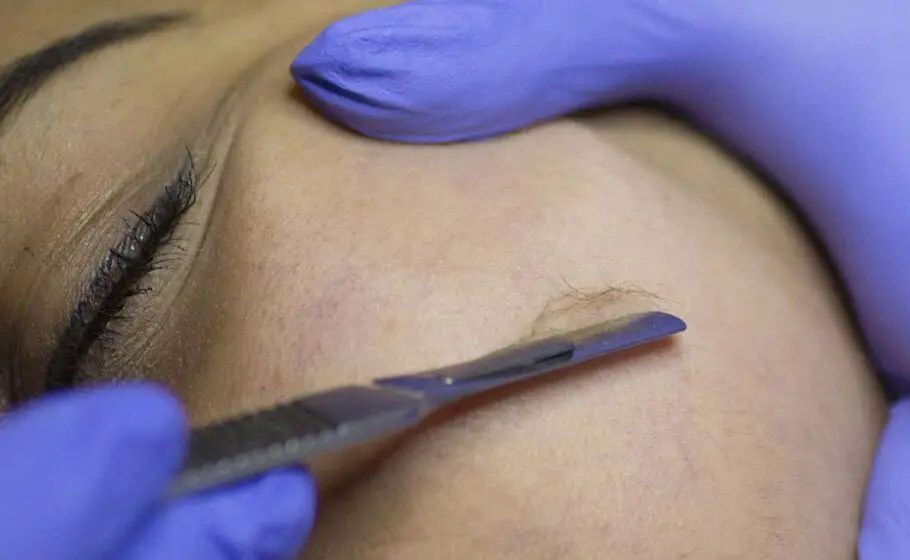
If you’ve cruised your face in a magnifying mirror lately, you may have noticed that the “peach fuzz” on your cheeks is looking a little downier.
As we age, we tend to get fuzzier. Notice that we didn’t say hairier. Peach fuzz—or vellus hair—is different from the other darker, thicker hair on your body. If the fuzz doesn’t bother you, read no more. But if you’ve noticed that your makeup doesn’t go on quite as smoothly as it once did, or if direct sunlight highlights a halo of goose down around your face, shaving your facial hair, or “dermaplaning” may help.
Vellus hair is the translucent, fine, wispy hair that appears all over our bodies at birth. It is more prevalent in females than in males. Vellus hair has a finite growing length, in contrast to terminal hair, which is typically dark and stronger and coarser. It is the hair on a man’s face (beards and mustaches). It continues to grow so it needs to be trimmed or cut to be managed.
It’s as old as Cleopatra
Although facial dermaplaning has come to the forefront recently and is all over the internet, it is a treatment that has stood the test of time. Beautiful women from Cleopatra to Marilyn Monroe to Elizabeth Taylor have employed a version of this process to achieve a polished complexion.
Dr Rabia Malik, a general practitioner and cosmetic physician at Grace Belgravia Medical in London, explains the age-old practice of “dermaplaning” like this: “Dermaplaning is an effective method of exfoliation. Using a scalpel blade, dead skin cells are removed from the epidermis (top layer of the skin). Along with exfoliating, dermaplaning also helps remove the unwanted vellus hairs from the face.” She continues, “Usually, you can see a difference after the first treatment. Not only will you achieve smoother, brighter skin but you’ll be free of peach fuzz.”

Huda Kattan, American makeup artist, beauty blogger, and founder of the cosmetics line Huda Beauty, claims that shaving off fine facial hair has anti-aging benefits. But most importantly, “Makeup application just becomes SO much more beautiful when you do it!”
Now let’s clear up some of the most frequent fears we hear from women on this topic. Whether or not you decide to shave, your decision should be based on facts, not on myths.
Myth: My hair will grow back thicker
No, it won’t. “But shaving always produces stubble,” you say. That’s true. But let’s put “stubble” in perspective. It’s true that the base of your hair (at the point it grows out of the follicle) is thicker than the end of the hair. In other words, hair is thicker the closer it is to the root, the root being the thickest part. This is true of both vellus and terminal hair.
Because vellus hair is so fine, however, the root of the vellus hair (although thicker than the end) is also extremely fine. So when you run your hands over your vellus hair “stubble” you will feel virtually nothing. And the entire strand of hair will not become any thicker regardless of the number of times you remove it. That’s because the texture of your hair is determined by DNA. This is true of terminal hair as well. When a man shaves his face, his hair does not get thicker each time he shaves it. The texture remains the same.
Myth: My hair will grow back darker
No, it won’t. It will grow back exactly the same color it was when you shaved it off. Terminal hair is the same. If you have blonde hair, and you shave your head, your hair will grow back blonde, not black. That’s because you are not doing anything to interfere with the root of the hair. You are simply cutting it off at the point it grows out of the follicle.
Myth: I will need to continue shaving my face once I start
No, you won’t. If you want to continue to shave your face, that’s up to you. But if you decide to stop at any time, your vellus hair will grow in exactly the same as it was before shaving. It won’t be thicker and it won’t be darker.
Fact: Vellus hair serves an important purpose
Yes, it does. Vellus hair provides both thermal insulation and cooling for the body. This insulation regulates body temperature: the vellus hair functions like a wick for sweat. However, remember that you have vellus hair all over your body and the area we are considering shaving is very small. Vellus hair also prevents bacteria from staying on your skin, thereby preventing breakouts. At our age, however, skin breakouts are mostly a thing of the past. If you cleanse your face regularly and practice good skin care, you won’t miss that particular role of your vellus hair.
Fact: Vellus hair grows back if you stop shaving
Yes, it does. If you decide dermaplaning is not for you, just stop doing it and your vellus hair will return. Dermaplaning does not pull vellus hair out by the roots from the follicle; it merely cuts it off at the point where you can see it. When you go to the salon for a haircut, they do not pull your hair out by the roots. Even if your hair is cut close to the scalp, you still have hair in your hair follicles. That means that your hair will grow back. Dermaplaning vellus hair is temporary and can be done inexpensively by you at home.
________________________________________________________
________________________________________________________
What about waxing, electrolysis and laser treatments to remove vellus hair?
If you remove the vellus hair on your face by the root (repeated waxing) or damage the follicle (laser treatment), those treatments are permanent. (Electrolysis is not a viable treatment for removing vellus hair as you have thousands of these hairs on your face. Electrolysis requires a needle to be inserted into each hair follicle—way too expensive and time-consuming to be a reasonable option.)
When your hair is removed by the root, you destroy the root and over time the hair will not grow back. Witness the many women with skinny, over-plucked eyebrows. You are better off to go the temporary route until you are certain that removing the vellus hair on your face is right for you.
Can I dermaplane at home?
For your first dermaplaning it’s a good idea to see a professional aesthetician. You will be able to see the tools, feel how the blade moves over your skin, and know what you’ll look like afterwards. After that you may decide to try it at home.
First you need the right tool. (And the razor in our feature photo is not it.) You are not going to use a man’s razor. A razor designed for a beard is simply not the best tool for shaving vellus hair. You will use a tool specifically designed for shaving a woman’s face and achieve far superior results.
So choose tools made specifically for the job. The best razors for dermaplaning look like the old barber shop straight razors except that the blade is shorter, the handle is plastic and they are not as heavy.
Dermaplaning razors are available on Amazon.com and at Sephora and some drug stores. One of the more popular razors mentioned in beauty blogs, and demonstrated by Marnie Goldberg in her video, is the Dorco Tinkle, praised for its low price, high quality and easy to use design.

How to dermaplane
- Watch what you are doing close up – If you don’t already have that 7x magnification mirror, now is the time to get one. If you didn’t get it for lip lining or eyebrow plucking, trust us: taking a sharp steel blade to the skin of your face should be the tipping point.

- The dry or wet debate – If you look at dermaplane videos online you will notice that some aficionados, like Marnie Goldberg, like to do it when their skin is dry. Others, like sixty-something British makeup artist Kerry Lou, like to lather up before blading. If you skin is very sensitive, or if you are prone to rosacea or broken capillaries, we recommend using a product to help the blade glide over your skin.
- Follow the direction of your hair – Vellus hair tends to grow in a U-shape around the cheeks, and under the nose, with the chin being the bottom of the U – much the way a man’s beard grows. Very gently, place your razor against your skin and skim it over the outer edges of your cheeks and near your hairline, following the direction of hair growth. Keep the razor free of hair by continually rinsing it under a tap.
- Moisturize with a soothing cream – When you have finished shaving, your skin may be a bit red because you have exfoliated at the same time you have removed the vellus hair. Use a soothing cream containing aloe or chamomile.
This YouTube video shows you how to remove facial hair using the Tinkle razor. At some point the woman’s dog walks into the room to observe. Watch the dog’s doubtful expression as she gets into her face shaving.
And one final word
Remember that others aren’t looking at you with magnifying glasses. Removing your peach fuzz is something that you do for yourself. If you love wearing makeup, it’s worth trying a hair-free face as the canvas for your next look. You will either be a convert (as many of the women in these tutorials say they are). Or you may just decide the extra step isn’t worth it. In the end, it’s up to you.
As an affiliate of Amazon and other retailers, Blue Hare makes a small commission on qualifying purchases made through the links on this page.
* * *
You may also like
- Red in the face: We look at rosacea and treatments that work
- Burgundy eyes and lips, the look of the moment
- Can women over 60 wear red lipstick? Yes, and we show you how
Go to the Blue Hare homepage for more articles for fabulous women
